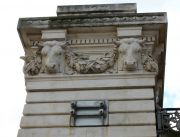Viaduc d'Austerlitz



























This is a steel arch railway bridge across the River Seine in Paris, with associated steel viaducts, which carry Metro Line 5 between Quai de la Rapée and the Gare d'Austerlitz. It has a parabolic 'half-through' steel arch of 140m (459 ft) span, with pin joints at the top centre and just above the deck level, hidden by cast iron ornaments. The deck is suspended from the arches by pinned steel plate hangers.
Built 1903-1905.
The engineers were Maurice Koechlin, Fulgence Bienvenüe and Louis Biette. The architect was Jean-Camille Formigé, who also designed the Pont Bir-Hakeim. The main contractors were La Societé de Construction de Levallois-Perret. The steelwork contractors were Daydé & Pillé.
The approach to the bridge from the right bank was made difficult by the adjacent constraints, and the solution is impressive. It features a curved riveted structure - a helicoid ramp.
For more information, see Structurae entry.
1936-8 The bridge was reinforced, using welded plates, to accommodate much heavier trains.[1]
Excellent series of old photos (postcards) here. Comparison with the recent photos shows some of the areas where the bridge was strengthened by welding on additional platework.
A presentation addressing the design, the 1930s strengthening, recent reinforcement, and in-service stresses may be found online here [2]
The viaduct provides a satisfyingly complex set of structures for bridge enthusiasts to study. By way of contrast, the adjacent Pont Charles de Gaulle is a sleek, modern and impressive way of getting traffic across the river, but does not offer much to delay the curious pontist.

